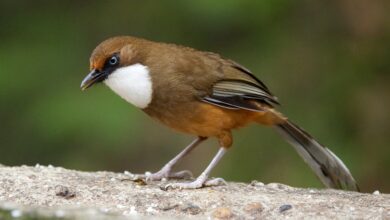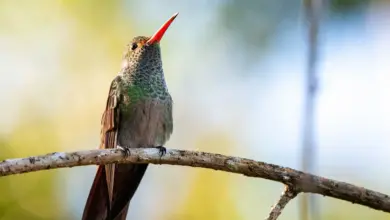Jackdaws (Corvus monedula)
The Jackdaws (Corvus monedula) – also commonly referred to as Eurasian Jackdaws – are small crows found from North West Africa through virtually all of Europe, Iran, north-west India, and Siberia, where they inhabit wooded steppes, woodland, cultivated land, pasture and coastal cliffs. They have also adapted well to urbanized areas.
They are mostly resident, but the northern and eastern populations migrate south for the winter.

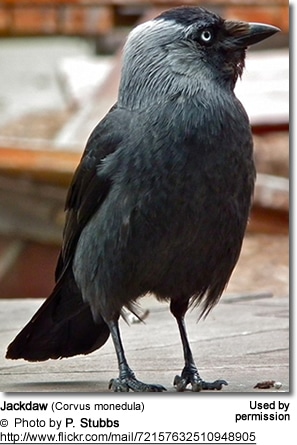
Subspecies, Distribution, and Identification:
Jackdaws are closely related to the Daurian Jackdaws. Some authorities consider them to be conspecific (one and the same species).
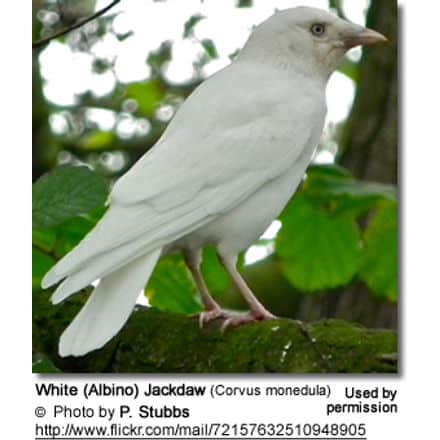
All races are about the same size and are difficult to differentiate for the most part – likely because of hybridization between the various races, resulting in a wide range of variations.
- Nordic Jackdaws, East European Eurasian Jackdaws, Scandinavian Jackdaws (Corvus monedula monedula – Linnaeus, 1758) – Nominate Race
- Range: Scandinavia – from southern Finland south to Esbjerg and Haderslev in Denmark, and eastern Germany and Poland, and stretching south across eastern central Europe to the Carpathian Mountains and northwestern Romania, Vojvodina in northern Serbia, and Slovenia. Occasionally winter in England and France. A rare vagrant in Spain.
- ID: Pale nape, purple-blue glossy crown, and dark throat. The silvery collar gradually darkens towards the west and southwest.
- Common Jackdaws or Western Eurasian Jackdaws (Corvus monedula spermologus – Vieillot, 1817)
- Range: Westernmost race. Occurs from the British Islands south to Morocco and northwestern Algeria.Winter in the Canary Islands and Corsica.
- ID: Darker plumage. Purple-blue glossy crown. The bill is slightly heavier and the middle toe is slightly longer than in the three other races (Cramp and Perrins 1994). Lacks the light collar of the other jackdaws within its range.
- Algerian Jackdaws, Algerian Eurasian Jackdaws, or Western Jackdaws (Corvus monedula cirtensis – Rothschild and E. J. O. Hartert, 1912)
- Range: Found in Morocco and Algeria in North Africa. Formerly found in Tunisia.
- ID: The plumage is duller and more uniform dark grey, with a paler, less distinct nape.
- East Eurasian Jackdaws, Eastern Jackdaws, Russian Jackdaws (Corvus monedula soemmerringii – J. G. Fischer von Waldheim, 1811)
- Range: Migratory race. Its range covers the former Soviet Union to Lake Baikal and north-west Mongolia, south to Turkey and Israel, and the Himalayas in the east. Winter across south Sweden to central Europe north of the Alps, and sometimes in northwestern Europe.
- Proposed subspecies: tischleri (northeastern Poland), sophiae (eastern Poland), schluteri (Belarus), collaris (Macedonia), pontocaspicus (Cyprus), and ultracollaris (Tien Shan)
- ID: Paler nape and side of the neck contrasting to the inky-black glossy crown (although some may have a purple-blue glossy crown).

Alternate (Global) Names
Arabic: ???? ????? … Bulgarian: ?avka, ????? … Catalan: Gralla … Chinese: [han-ya], ? ?, ?? … Czech: kavka, Kavka obecná … Dutch: Kauw … Danish: Allike … Finnish: Naakka … French: choucas, Choucas des tours, Choucas gris … German: Dohle … Greek: (?????????) ??????, [kargia], kargia, ?????? … Irish: cág, Cathóg, gralla cereixeira … Hebrew: ??? … Croatian: Cavka, ?avka, ?avka zlogodnja?a … Hungarian: Csóka … Armenian: [Sovorakan Chay ], ????????? ??? … Icelandic: Dvergkráka … Italian: Taccola, Taccola eurasiatica … Japanese: Fuyu-garasu, Kan-garasu, Nishi koku-maru garasu, nishikokumarugarasu, Nishi-kokumaru-garasu, nishikokumarukarasu … Korean: ???? … Cornish: chogha … Mongolian: ??? ??????? … Maltese: ?awla … Norwegian: Kaie … Polish: kawka, Kawka zwyczajna … Portuguese: gralha de nuca cinzenta, Gralha -de- nuca -cinzenta, Gralha-de-nuca-cinzenta … Russian: Galka, ?????, ????? ???????????? … Scots: cathag, Gathag … Slovak: kavka, Kavka oby?ajná, kavka tmavá … Slovenian: kavka … Albanian: Gala, stërqoka … Serbian: cavka, ?avka, ????? … Swedish: Kaja … Turkmen: küçük karga … Turkish: Küçük karga … Tuvinian: ???? … Ukrainian: galka, ????? … Spanish: Casanueces, Grajilla, Grajilla Común, Grajilla Occidental, Grajilla ?omún … Welsh: Cawci, Coegfran, Cogfran, Corfran, Jac ffa, jac-do, jac-y-do
Description
The Jackdaws are the smallest of all crows – measuring between 13 – 15 inches (34–39 centimeters) in length (including the tail).
The plumage is black or greyish black, except for the cheeks, neck, and nape, which are light grey to greyish silver.
Occasionally, rare albino (white) jackdaws can be found (photo further above).
The adults have greyish white or silvery-white eyes. Juveniles have light blue eyes.
By the end of March, their plumages look worn and adult Jackdaws molt their primary and secondary wing feathers and tail feathers from mid-May to mid-October (Cramp and Perrins 1994).
Diet
Jackdaws mostly take food from the ground but also forage in trees. They feed on insects and other invertebrates (= animals without internal skeletons, such as larvae, earthworms, millipedes, snails, and spiders), weed seeds and grain, scraps of human food, stranded fish on the shore, and will also take food from bird tables.
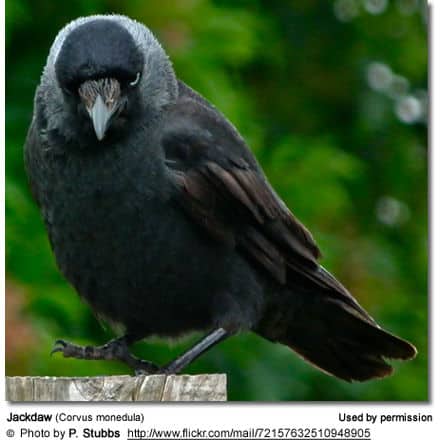
Nesting
Jackdaw nests are constructed in holes in rocks, trees, or buildings.
The average clutch consists of 4 – 5 eggs which are incubated for 17 – 18 days. The young fledge when they are about 30 – 35 days old.
Calls / Vocalizations
Their calls are described as a loud “tchak-tchak” or “kak-kak”. They also make hoarse, drawn-out alarm calls.
Crow Intelligence
Crows are exceptionally intelligent birds. Some species have a neostriatum (forebrain) of the same relative size as the chimpanzee and human. They have been known to:
- Use bread crumbs to bait fish.
- Establish the flock’s pecking order by “sparring” in mid-air.
- Construct and use tools effectively; for example, the New Caledonian Crow has formed crude cutting tools from stiff leaves and stalks of grass; they have also been observed to drop very hard nuts into a street and wait for them to be crushed by passing cars.
- Hide and store food from one season to the next.
- Remember events.
- Use past experiences to predict the behavior of those in their species.
- Differentiate one human from another by his or her facial features.





